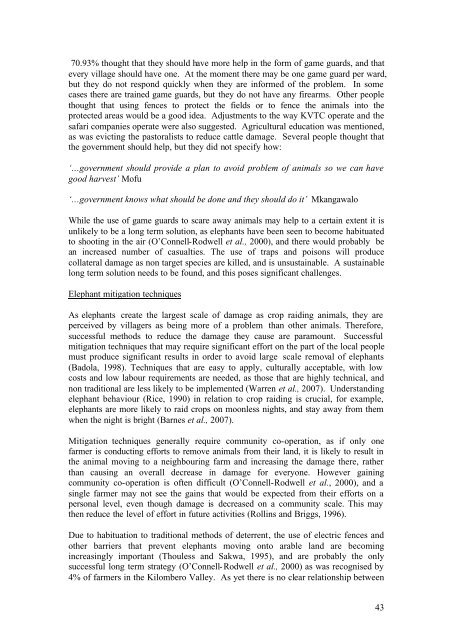Frontier Tanzania Environmental Research - Frontier-publications ...
Frontier Tanzania Environmental Research - Frontier-publications ...
Frontier Tanzania Environmental Research - Frontier-publications ...
Create successful ePaper yourself
Turn your PDF publications into a flip-book with our unique Google optimized e-Paper software.
70.93% thought that they should have more help in the form of game guards, and thatevery village should have one. At the moment there may be one game guard per ward,but they do not respond quickly when they are informed of the problem. In somecases there are trained game guards, but they do not have any firearms. Other peoplethought that using fences to protect the fields or to fence the animals into theprotected areas would be a good idea. Adjustments to the way KVTC operate and thesafari companies operate were also suggested. Agricultural education was mentioned,as was evicting the pastoralists to reduce cattle damage. Several people thought thatthe government should help, but they did not specify how:‘…government should provide a plan to avoid problem of animals so we can havegood harvest’ Mofu‘…government knows what should be done and they should do it’ MkangawaloWhile the use of game guards to scare away animals may help to a certain extent it isunlikely to be a long term solution, as elephants have been seen to become habituatedto shooting in the air (O’Connell-Rodwell et al., 2000), and there would probably bean increased number of casualties. The use of traps and poisons will producecollateral damage as non target species are killed, and is unsustainable. A sustainablelong term solution needs to be found, and this poses significant challenges.Elephant mitigation techniquesAs elephants create the largest scale of damage as crop raiding animals, they areperceived by villagers as being more of a problem than other animals. Therefore,successful methods to reduce the damage they cause are paramount. Successfulmitigation techniques that may require significant effort on the part of the local peoplemust produce significant results in order to avoid large scale removal of elephants(Badola, 1998). Techniques that are easy to apply, culturally acceptable, with lowcosts and low labour requirements are needed, as those that are highly technical, andnon traditional are less likely to be implemented (Warren et al., 2007). Understandingelephant behaviour (Rice, 1990) in relation to crop raiding is crucial, for example,elephants are more likely to raid crops on moonless nights, and stay away from themwhen the night is bright (Barnes et al., 2007).Mitigation techniques generally require community co-operation, as if only onefarmer is conducting efforts to remove animals from their land, it is likely to result inthe animal moving to a neighbouring farm and increasing the damage there, ratherthan causing an overall decrease in damage for everyone. However gainingcommunity co-operation is often difficult (O’Connell-Rodwell et al., 2000), and asingle farmer may not see the gains that would be expected from their efforts on apersonal level, even though damage is decreased on a community scale. This maythen reduce the level of effort in future activities (Rollins and Briggs, 1996).Due to habituation to traditional methods of deterrent, the use of electric fences andother barriers that prevent elephants moving onto arable land are becomingincreasingly important (Thouless and Sakwa, 1995), and are probably the onlysuccessful long term strategy (O’Connell-Rodwell et al., 2000) as was recognised by4% of farmers in the Kilombero Valley. As yet there is no clear relationship between43
















